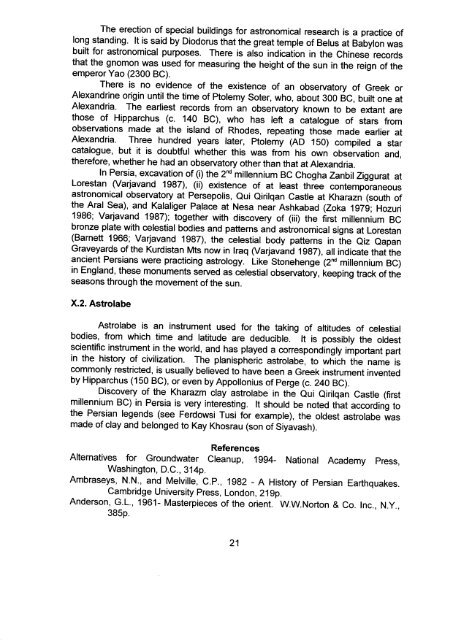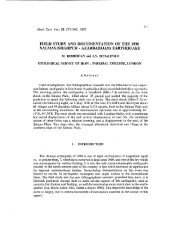PDF COPY - Manuel berberian
PDF COPY - Manuel berberian
PDF COPY - Manuel berberian
Create successful ePaper yourself
Turn your PDF publications into a flip-book with our unique Google optimized e-Paper software.
The erection of special buildings for astronomical research is a practice oflong standing. lt is said by Diodorus that the great temple of Belus at Babylon wasbuilt for astronomical purposes. There is also indication in the Chinese recordsthat the gnomon was used for measuring the height of the sun in the reign of theemperor Yao (2300 BC).There is no evidence of the existence of an observatory of Greek orAlexandrine origin until the time of Ptolemy Soter, who, about 300 dC, built one atAlexandria. The earliest records from an observatory known to be extant arethose of Hipparchus (c. 140 Bc), who has left a catalogue of stars fromobservations made at the island of Rhodes, repeating thosL made earlier atAlexandria. Three hundred years later, ptolemy (AD 150) compiled a starcatalogue, but it is doubtful whether this was from his own observation and,therefore, whether he had an observatory other than that at Alexandria.In Persia, excavation of (i) the 2nd millennium BC Chogha Zanbil Ziggurat atLorestan (Varjavand 1987), (ii) existence of at least three contemporaneousastronomical observatory at Persepolis, Qui Qirilqan Casfle at Kharazn (south ofthe Aral Sea), and Kalaliger Patace at Nesa near Ashkabad (Zoka lg7g; Hozuri1986; Varjavand 1987); together with discovery of (iii) the irst millennium BCbronze plate with celestial bodies and patterns and astronomical signs at Lorestan(Barnett 1966; Varjavand 1987), the celestial body patterns in the eiz eapanGraveyards of the Kurdistan Mts now in lraq (Varjavind 1987), all indicate that theancient Persians were practicing astrology. Like Stonehenge (2"d millennium BC)in England, these monumentserved as celestial observatory, keeping track of theseasons through the movement of the sun.X.2. AstrolabeAstrolabe is an instrument used for the taking of altitudes of celestialbodies, from which time and latitude are deducible. lt is possibly the oldestscientific instrument in the world, and has played a correspondingly important partin the history of civilization. The planispheric astrolabe, to wniin the name iscommonly restricted, is usually believed to have been a Greek instrument inventedby Hipparchus (150 Bc), or even by Appollonius of perge (c. 2a0 BC).Discovery of the Kharazm clay astrolabe in the Qui Qirilqan Casle (firstmillennium BC) in Persia is very interesting. lt should be noted that according tothe Persian legends (see Ferdowsi Tusi for example), the oldest astrolabe wasmade of clay and belonged to Kay Khosrau (son of siyavash).Alternatives for Groundwater tfffil"J"%no- Nationat Academy press,Washington, D.C., 314p.Ambraseys, N.N., and Melville, c.p., 1gg2 - A History of persian Earthquakes.Cambridge University press, London, 21gp.Anderson, G.L., 1g6i- Masterpieces of the orient. w.w.Norton & co. Inc.. N.y..385p.21







